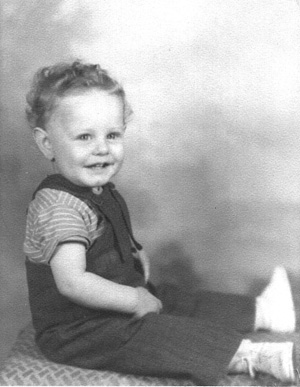
 |
I Arrived
I was born in Bremerton Washington in 1944 to Thomas Maynard Blake, and Lydia Florence (Leistiko) Blake. This was near the end of World War II. My parents, both from Anaconda, had moved to Bremerton where they were working in the naval shipyards as part of the War effort. When the war was over, they, and I, returned to Anaconda, and they returned to a life that was much like it had been before the war. My Dad went back to his job on the Copper Smelter, Anaconda’s major industry. He had worked there before the war. As was customary in those days, Mom stayed home to raise me. My two sisters, Mary Blake and Thomasina (Tommy) Blake did not return to Anaconda. They were born 17 and 15 years prior to me, and wound up getting married before my Parents returned from Bremerton.
I Arrived in Anaconda
Growing up in Anaconda in the 1950’s and early 60’s was a memorable experience for me. My folks bought a home at 506 Hickory Street in 1950, the year I started the first grade. It was a one-block walk down Hickory Street to the Daly school where I attended grades 1 through 6. Adjoining the Daly School was the Junior High School that faces Main Street, and if I went the long way, it was a two-block walk to attend grades 7 through 9. The Anaconda High school was 1 block east of Hickory, also facing Main Street. It was there that I attended grades 10 through 12.
I Had to Walk in Blizzards
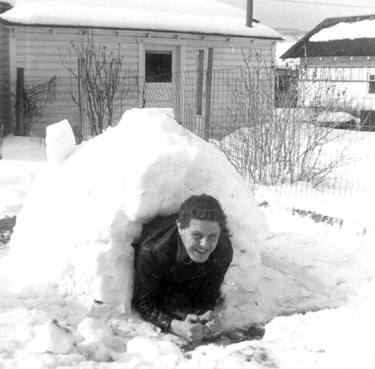 |
I will never be able to truthfully tell my Grandchildren that I had to walk 10 miles to school in a blizzard, uphill both ways, as the old joke goes. Even though I didn’t have far to go to school, I can tell them that I had to walk to school in blizzards, and we had some good ones over the years. Anaconda boasts an elevation of over 5,000 feet, and is truly a mile high. The area traditionally caught some of the worst winter weather that Mother Nature could dish out. As kids, we loved the snow. Our parents would dress us up in layer upon layer of clothing to the point that sometimes it was hard to move your arms and legs. Then they would send us off to school or out to play, confident that we could not freeze to death even in the worst of conditions. All of our toys were geared for that climate. I had a sled, ice skates, skis, and some of the kids had toboggan sleds. Winters were great in Montana.
Summer Activities
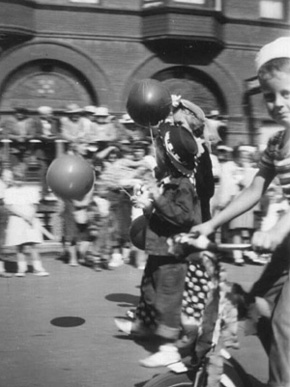 |
Summers brought a whole different venue to our lives. When your body and mind are geared for 4 distinctly different seasons, the changes are always welcome, so you put away the ice skates and start looking for your fishing pole. Fishing for Trout in Warm Springs Creek, hiking the Rocky Mountains in any direction, swimming in the mountain lakes and streams were some of the activities of summer. There were picnics at Washoe Park, little league baseball on the City Commons, and on August 8th every year, the Smelterman’s day parade. Smelterman’s day was special for every Anaconda kid, because if you walked in the parade, you were handed a silver dollar at some point, and back in those days a dollar was a lot of money. Some of the more clever kids ran around the block, went back through the line again, and got 2 or even 3 or more dollars during the parade. Following the parade a big picnic at Washoe Park was always hosted by the Smeltermen. Free sack lunches were given to all the kids. What a great day that was.
Family Grocery Stores
Back in those days, we had a lot of neighborhood grocery stores. This was before supermarkets and corporate chain stores, discount food chains, and the like. The service was personal and the storeowners knew most all the kids by name. Our parents would send us to these stores for bread, milk and other essentials, and of course, to get us to go, they would give us a few cents extra for CANDY. These stores did a land office business in penny candy, and sometimes you could get four or five pieces for a penny. Each store had big jars of the stuff and for 10 or 15 cents, you could walk out with a big sack full of candy. These stores were doomed when the big stores began to move in to even the little towns like Anaconda, and one by one they began to disappear in the late 50’s. An acquaintance of mine has a website that is extremely interesting to anyone from (or interested in) Anaconda. I like to check the “comments” section, because I always see names that I recognize from years ago, people checking the site and leaving their comments. It is http://www.bigstack.com. There is a considerable amount of discussion on this site regarding the names and locations of most of the “Mom and Pop” or “Family” grocery stores from years gone by. Check the posted comments of early to mid 2003. Thanks to Carl Lanes for this marvelous site. (Be sure to check out his “Time Machine”.)
The Movies
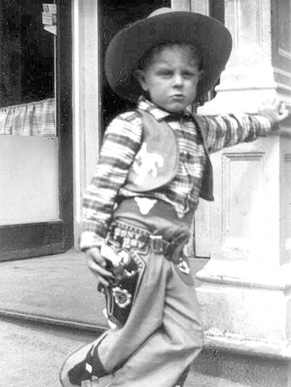 |
We had two movie theatres while I was growing up in Anaconda. The Washoe Theatre on the east side of Main Street, between third and fourth streets, is still operating as of this writing, and is still operated by the Lussy Family. The Center Theatre, which was located on the northeast corner of Park and Oak streets, is gone now. There were two other theaters in town, but were gone before my time. The old Bluebird became the Center Theatre after a fire and remodeling job, I have been told, and another theatre, the Margaret was converted into some other kind of store. You can still see some traces of the old Margaret (some of the old red and black tile squares are still there) in the storefront that exists there now. It was located on the south side of Park Street two or three blocks east of the old Center Theater. Going to the movies was one of our favorite pastimes as kids. The Saturday afternoon matinee’s cost a dime to attend, and you could get a pretty hefty box of popcorn for another dime. Coke’s were a nickel or a dime for a large one, and most candies were a nickel. The movies that were the most popular back then were the Cowboys. Roy Rogers, Gene Autrey, Hopalong Cassidy, Tom Mix, Rex Allen, and a host of others rode across those silver screens thousands of times while I was growing up. They had completely tamed the West by the time I was in High School. Of course no movie was complete in those days without two other additions. First, the theatres always showed a cartoon before any feature film, and the weekly Serial which always left someone hanging over the edge of a cliff so that you absolutely had to come back to the theatre next week to see how they were going to escape certain death. The kids in the neighborhood where I lived would all go to the matinee on Saturday. (It was obligatory) Then we would spend Saturday evening and a good chunk of Sunday trying to act out the movie. The bigger kids always got to play the parts of the heroes, and the smaller kids were just the hired hands.
A Visit to Anaconda
I can date the writing of this piece, because I visited Anaconda last year, 2002, in August, for my 40th year high school class reunion. While at the reunion I visited with many individuals that I had known since the first grade and throughout High School. If you think you remember any of the people from that era, check out the “Class of 62” website at: http://www.freewebs.com/ahsclassof1962/. We talked a lot about the way things were when we were kids growing up in Anaconda, and how different things are now. For all of its bravado and tough talk, Anaconda was a safe place for kids. Seldom did anyone ever bother us, and if they did, we were probably asking for it.
Dangerous Sport
Speaking of asking for it: “Shagging” was a dangerous sport in the late 50’s. It consisted of yelling obscenities at older teenagers who were driving by in their cars, and then trying to outrun them when they inevitably gave chase. Most of the time we could escape unharmed. However, on more than one occasion, I got caught by the older kids and found myself running down Sunnyside Road with no clothing on. Sometimes we also got the “red hot” treatment. (a red pepper concoction that really irritates the skin.) They would rub it on or about your private parts, and it burned like hell. After being caught, taken up there, stripped naked, and dumped off by your captors they would further humiliate you by honking their horns all the way back down Sunnyside road alerting residents that a “show” would come running by shortly. Of course, the residents who knew of this practice would usually come out and shine flashlights on you and laugh at you as you went streaking by. Usually when you reached the end of Sunnyside road coming into town, you would find your clothing in the middle of the road tightly tied into knots. Let me tell you, this was not a sport for kids that couldn’t run very fast.
Bikes
By the time we were around 10 years old, most of us in the neighborhood had bicycles. Across the alley from me in a house facing Locust Street, my friend Don Nelson lived with his grandparents. Four houses up from him, also facing Locust Street, lived my best friend, Bill Forwood, who is a month older than me. (Bill and I met in 1950, probably the day after my parents and I moved into the house on Hickory Street, and are still friends to this day.) Along with some of the other neighborhood kids the three of us would ride our bicycles everywhere. Each summer was a bike-fest. We would range from as far west as the lime quarry, and east to the ‘red sands’. We discovered new kids all the time, and new places to go, and fun things to visit. It seemed like nowhere was out of our range. After a couple of years on bicycles, we started experimenting with old lawn mower motors. We had been building “carts” for some time. It was inevitable that we would try to power our carts with engines, although we never had much success with them.
Wheels
I don’t think there was a baby buggy anywhere in Anaconda with wheels on them. They had all been appropriated for “carts”. These carts were built out of wood and kids from all over Anaconda tried to build them according to pictures of something we saw called the “Soapbox Derby”. I never did know where this event was held, but some of the kids (or their Fathers) built some pretty nice carts. Our neighborhood carts for the most part usually consisted of a long plank with two by fours nailed on for the rear axles, and a two by four attached to the front by a single bolt so you could swivel it and thereby steer the cart. Of course, then came the wheels. Wheels of all sizes, shapes and descriptions decorated our carts. We used to pull them up the road to the cemetery, and then ride them down at breakneck speeds. I don’t know if anyone ever made it all the way to the bottom in one continuous ride, because breakdowns, steering problems, wheels falling off, and such were pretty common on these rides.
Motorcycles and Cars
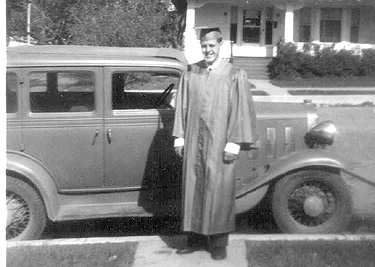 |
These carts held our enthusiasm for quite awhile, or at least until we discovered Motorcycles and Cars. These discoveries took place at an early age. In the spring of 1959 Don Nelson, who was 16 years old then, bought a 1947 “Indian Chief” motorcycle. Three days later, I bought my first Harley Davidson Motorcycle. It was a 1946 model. I was 14 years old then. Don and I terrorized the streets of Anaconda for the next couple of years along with some other motorcycle riders. All the parents were locking their daughters away for safekeeping. I bought my first Car when I was 15. It was a 1950 Chevrolet, 2-door hardtop sedan. It was yellow with white trim, and had loud exhaust pipes, so I was sure to be noticed when I drove it. (No picture available). Once we had cars, things changed in our lives forever. We had achieved a “grown up” status that would continue on wherever we went after that. The 1932 Chevrolet shown in the picture on “Graduation Day” in 1962 was actually my “second car.” I bought it in 1960 for $50.00 from a classmate’s Dad. I was visiting Dave Bock at his house. The Chevy was buried under a pile of rubble in their back yard at their house up in the 800 block on Alder Street. I had to buy tires for it before I could tow it home. I restored it to the condition you see it in the picture, and actually drove it for several years. It was a fun car.
Roots
Growing up in Anaconda was a rich and rewarding experience because we had “roots”. My oldest Son, Steve once went with me on a trip to Anaconda to visit friends and relatives. I had moved away from Anaconda some 25 years earlier. We went in to the “Park Café” on the 100 block of East Park Street for lunch, and while there, we were waited on by one of my cousins, Sharon (Leistiko) Wicks, and we got to discuss family. Her sister, Arlene also worked there, so Steve got to meet two of his “second cousins.” All during lunch, old friends and acquaintances stopped at our table when they saw me and said, “Hello Blake”. Many of them asked, “You back now?” to which the answer was, “Naw, just visiting.” The reply to that was, “Ok, have a good time. See ya later.” Steve’s comment was that people who recognized you, talked to you like they had seen you last week, and expected to see you again next week. He liked that and was very impressed. I must say that this situation still exists every time I visit Anaconda, and it still makes it a joy to visit “Home”. Though I have spent most of my later years until the present time in the Los Angeles area, I always think of Anaconda with nostalgia for the way things were when I was growing up there.
Going Home?
As a closing thought, many of the people that I have been in touch with over the last many years who were originally from Anaconda, have indicated to me that they plan to return to either Butte or Anaconda when they retire. I plan to stay in California myself, but I guess I’m not the only one who feels the “nostalgia” for the place I grew up.
Dave Blake
5306 Cangas Drive
Agoura Hills, CA 91301
Phone: (818) 889-3201
E-mail: davandlor@juno.com